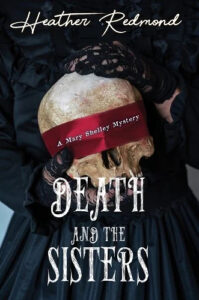I find myself reflecting on my own teen years as I tackle Frankenstein-author Mary Shelley and her step-sister at age sixteen years for my new series, which begins with Death and the Sisters. Mary and her kaleidoscope of siblings gathered opinions and values from the books they read in their highly literary household. With both of Mary’s parents having been acclaimed authors, she took her world view, her values, and story prompts from her parents’ novels. I didn’t have the experience of philosophers and novelists in my family when I first started to write, so what was I picking up in my reading?
As I, a historical mystery novelist, direct a teen reader to more mature reading, I have another reason to revisit my literary consumption. The first adult mystery suitable for teens that came to mind was The Cat Who Read Backwards by Lillian Jackson Braun. I was excited to buy a copy to give to my son, then laughed when I discovered my teen reading starred a middle-aged man. Not only that, the book was so old-fashioned that the main character finds an electric pencil sharpener suspicious. Originally published in 1966, the book found its way back into print in 1986, when I must have discovered it at the end of my high school years.
Recovering this old favorite made me want to start a rereading project, where I considered some of my darlings as the historical mysteries they have become. Some of my favorites, like books from Elizabeth Peters and Carole Nelson Douglas, were already set in the past in their first incarnations. Many others were contemporary to their time. I remember reading how Sue Grafton grappled with that issue in her long-running Kinsey Millhone series. She decided to keep her time period realistic, which meant as the series progressed, she was looking deeper into the past with her continued 1980s setting.
Can these books hold up to today’s historical fiction? What was I learning from these books back then, when I wanted to be a writer but hadn’t yet figured out how to compose a novel? Here are eight of my favorites, all with lessons to offer.

1982 – A is for Alibi by Sue Grafton
I was reading this private eye series with a very nuanced main character in an omnibus edition in college. I remember being so entranced by the books that this was a rare occasion where I would walk to a local library branch and have them put on hold for me so I could devour them. Grafton’s voice is incredibly strong. The twist on the first page is masterful and reminds me that you can never start building suspense too early. As for the historical details, the clothing and cars are definitely touches that read old-fashioned now, and a main supporting character is living a lifestyle that was going out of fashion by the 80s, which is a nice way to create a sense of setting, had this been written in 2023. The sleuth is very completely realized, and writers would do well to pay attention to how Grafton builds up Kinsey’s character and quirks.
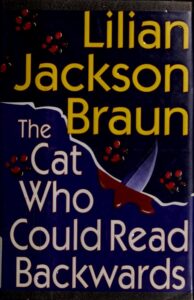
1986 – The Cat Who Read Backwards reprint by Lillian Jackson Braun
Sometimes, my Gen X brain doesn’t even pick up on the historical details in this series. The mention of typewriters, for instance, scarcely reads as out-of-time to me. I had early jobs where I actually used typewriters in my work, and I owned one through my college years even though I bought my first computer at 16. This reminds me that everyday details aren’t necessarily poured over by readers, but they create a background hum that gently builds the historical environment. The Cat Who Read Backwards is a great example of worldbuilding for profession, journalism, and the newspaper environment, which has changed a lot in the past sixty years. It cleverly refers back to an even earlier timeframe due to the main character’s befuddlement with the progress of his own long-term career.
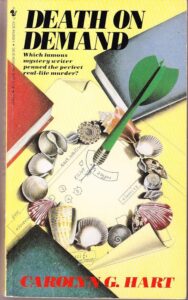
February 1987 – Death on Demand by Carolyn Hart
I was a freshman in college when this book appeared. I remember investing in the series with my limited dollars. The casual sexism in these old books is a bit overwhelming, though I like how this heroine, an actress-model who inherits a bookstore on a southern island, is fighting against it. We see how she is set up to be an independent thinker, but a bit of the premise here wouldn’t work now. It would not take three months to find a business owner in 2023. I also noticed there is less interest in real police procedures in these older books. Even the coziest of authors tend to get the facts right these days, or at least we assume the police are more professional. The other thing I am noticing is how good these books are. I’m enjoying their charm just as much as I did when they were new. It’s such a treat to discover old favorites are aging well.
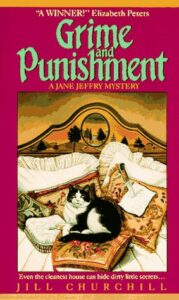
1989 – Grime and Punishment by Jill Churchill
This delight is a take on cozy mystery that reads very old-fashioned to my eyes. Churchill’s Chicago setting reminds me of the neighborhood of my childhood. It very much reads as a historical setting, including the smoking. It offers a good sense of how more interconnected neighbors used to be before most women were in the workforce, and everyone is staring at phones and other devices instead of interacting in person. The text is not afraid of sexual content, unusual in today’s cozies, and there is more of a focus on family. You might see a cozy amateur sleuth with one child, like in my Journaled to Death, but three with needs? When is there time to sleuth?
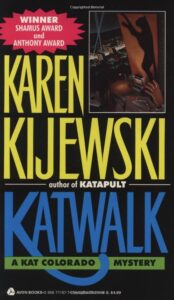
1989 – Katwalk by Karen Kijewski
Katwalk is still on my bookshelf after all these years. This is another female-led private detective series, with a previous bartending career that plays a role. I loved the Sacramento base, since I was living there in the early nineties and it helped clue me in to what landmarks, lifestyle choices, and cultural issues to refer to when writing my own work. The airport experience is different to what is described here now, but the corruption inherent to the plot hasn’t changed. It’s from before the cell phone era, which drives a lot of the movement of our private eye heroine. It wouldn’t be the same investigation now, but issues with property development continue.
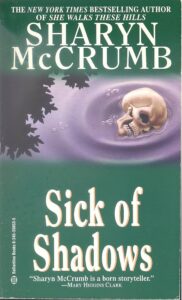
July 1989 – Sick of Shadows reprint by Sharyn McCrumb
This book reminds me of the joy of using letters in fiction, though using the mail points to a historical title. There is a brilliant end of act one twist, but the POV changes and mental illness aspects also make it read as a novel from past years. The heroine, a young woman who has just graduated from college without a job or a plan and is on a long trip for a family wedding, feels set in the past. Readers can recognize the changing times of the era when it was written by the amateur sleuth’s lifestyle confusion due to dumping her planned husband. The same premise is found in the TV show Friends, set some five years later than this book. Families with mental health issues and secrets and money continue to be the linchpin of a lot of fiction today.
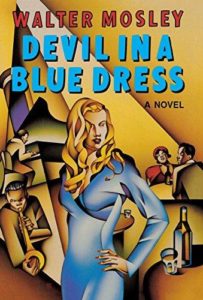
1990 – Devil in a Blue Dress by Walter Mosley
Despite the 1948 setting, the language in this crime masterpiece feels very modern. On the other hand, the style is reminiscent of both a Jane Austen novel, in the way it tells rather than shows some important scenes, and also 1970s crime movies in its intensely corrupt urban landscape. Who can forget the atmospheric movie starring 90s heartthrob Denzel Washington? The book itself, though, is intensely emotional. The consequences of the racism depicted here are heartbreaking, but the amount of drinking and smoking in the book also sets it back in time as much as the references back to military service in World War II. There is much to be learned here about how to tug a reader’s heartstrings while still keeping respect for the sleuth.

Mar 1991 – Silver Pigs reprint by Lindsey Davis
This is another mystery that has never left my shelf since I first discovered it. Set in Ancient Rome, the humor in this long running series is utterly disarming. The characters are so vivid, and the details shared are such that you are immersed in the imaginary world. It is a master class in how to create a long-lost environment. I appreciate the maps and the cast of characters, which I have employed in my own historical novels to ground readers. Another building block of my own fiction is seen here in the strong female characters. No wonder I wanted to write historical mystery with predecessors like this!
***


